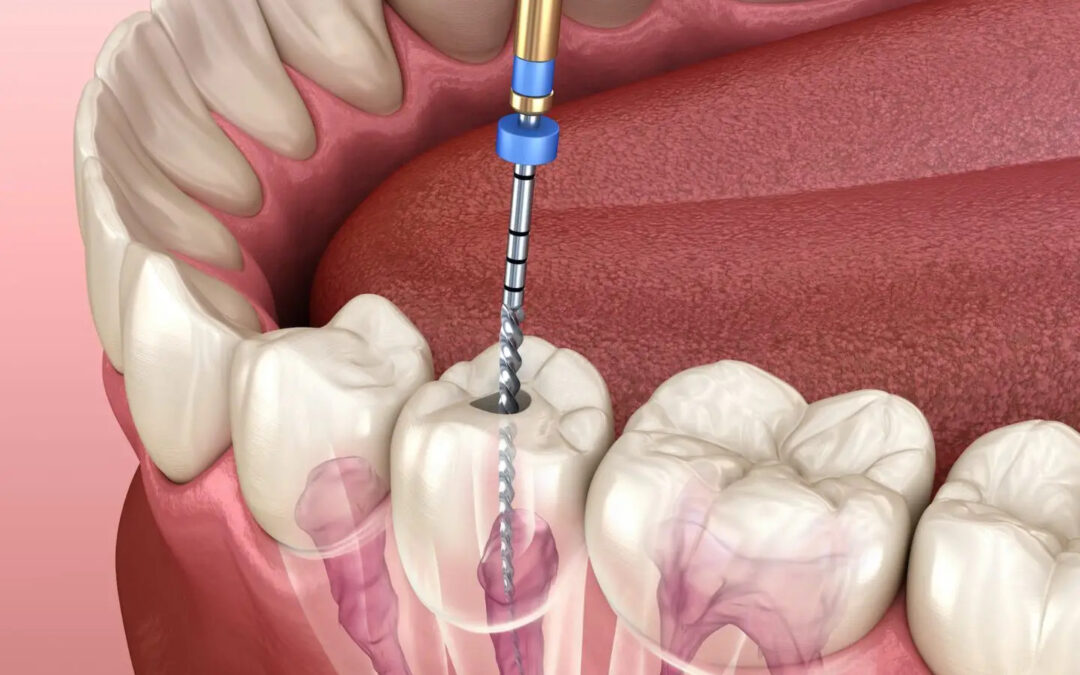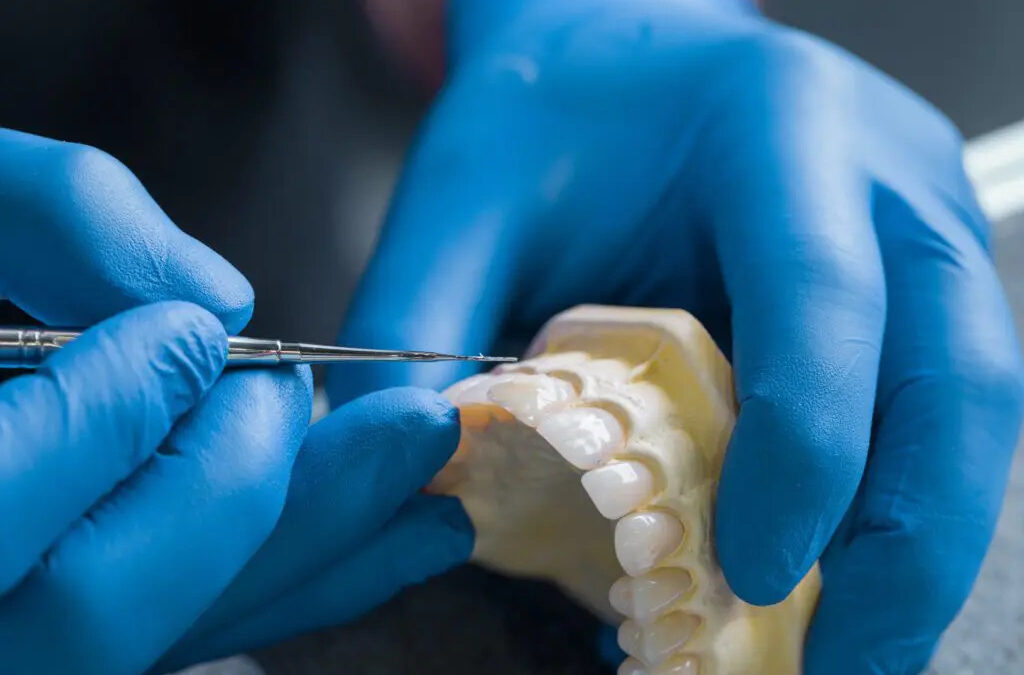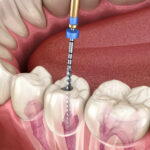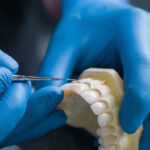Diet Safety & Body Nutrients is here to help you with your goals, whether it is to lose weight, tone up or improve health, we are here for you.

Root Canal Therapy: Restoring Comfort and Preserving Smiles
Welcome to our blog post on the topic of root canal therapy – where we delve into the world of oral healthcare and how this treatment can restore comfort and preserve smiles. If you’ve ever experienced tooth pain or have been advised by your dentist that you may need root canal treatment, then this article is for you! We’ll explore what exactly root canal therapy entails, why it’s necessary in certain cases, how it’s performed, and what to expect during the recovery process. So grab a cup of tea (or your beverage of choice) and let’s dive in together as we uncover the ins and outs of this important dental procedure. And hey, if you’re interested in even more tips on maintaining optimal oral health, stick around because we’ll also be exploring social media channels for valuable insights and advice. Let’s get started!
What is root canal therapy?
What is root canal therapy? It’s a question that often comes up when discussing dental procedures. Root canal therapy, also known as endodontic treatment, is a procedure performed to save and restore teeth that have been severely infected or damaged.
The interior of our teeth contains a soft tissue called pulp, which houses nerves, blood vessels, and connective tissues. When this pulp becomes infected or inflamed due to deep decay, cracks in the tooth enamel, or trauma to the tooth, it can cause severe pain and sensitivity.
Root canal therapy aims to remove the infected or damaged pulp from within the tooth’s interior. The process involves cleaning out and disinfecting the root canals before filling them with a special material called gutta-percha. This helps seal off any potential sources of infection and prevents further damage.
By addressing these issues through root canal treatment rather than resorting to extraction, we can preserve natural teeth and maintain proper oral function. Plus, preserving your natural smile has aesthetic benefits too!
Understanding what root canal therapy entails is crucial for anyone facing this possibility at their dentist’s office. Now that we’ve covered the basics let’s delve deeper into why you might need this treatment in the first place!
Why do I need root canal therapy?
Root canal therapy is a dental procedure that is necessary when the pulp of your tooth becomes infected or damaged. The pulp is the soft tissue inside the tooth, containing blood vessels, nerves, and connective tissue. When this delicate interior becomes compromised, it can lead to severe pain and discomfort.
There are several reasons why you might require root canal therapy. One common cause is deep decay or cavities that have reached the inner layers of the tooth. Trauma or injury to the tooth can also damage the pulp. In some cases, repeated dental procedures on a specific tooth can weaken it and make it susceptible to infection.
If you experience persistent pain in a particular tooth, sensitivity to hot or cold temperatures, swelling around the gums, or discoloration of the affected tooth, these may be signs that you need root canal therapy.
During this procedure, your dentist will remove the infected or damaged pulp from within your tooth’s interior. This helps alleviate pain and prevents further spread of infection. After removing the pulp, they will clean and disinfect the area before sealing it with a filling material.
By addressing issues within your teeth through root canal treatment early on, you can preserve your natural smile while enjoying restored comfort in daily life.
How is root canal therapy performed?
Root canal therapy, also known as endodontic treatment, is a procedure performed to save a tooth that has been severely damaged or infected. It involves the removal of infected or damaged pulp from within a tooth’s interior, with root canal treatment addressing this issue.
So, how exactly is root canal therapy performed? First, your dentist will begin by numbing the area around the affected tooth using local anesthesia. This ensures that you don’t feel any discomfort during the procedure. Once you’re numb and comfortable, your dentist will create an access point in the tooth by drilling a small hole.
Through this access point, specialized instruments are used to remove the infected pulp from inside the tooth’s canals. The canals are then thoroughly cleaned and disinfected to eliminate any remaining bacteria. After cleaning, your dentist will fill and seal the canals with a rubber-like material called gutta-percha.
In some cases where extensive damage has occurred or for additional support, your dentist may recommend placing a dental crown over the treated tooth. This helps restore its functionality while protecting it from further damage.
Root canal therapy is typically completed in one or two visits to your dentist’s office depending on individual circumstances. Following the procedure, you may experience minor discomfort which can be managed with over-the-counter pain medications prescribed by your dentist.
Remember to always consult with an experienced dental professional who can assess your specific situation and provide appropriate guidance for preserving both comfort and smiles!
What can I expect after root canal therapy?
After undergoing root canal therapy, it’s natural to wonder what you can expect in terms of recovery and post-treatment care. The good news is that most patients experience minimal discomfort following the procedure. You may have some soreness or tenderness around the treated tooth for a few days, but this can usually be managed with over-the-counter pain relievers.
It’s important to follow your dentist’s instructions for post-treatment care. This typically includes avoiding chewing on hard or sticky foods until the area has fully healed. You may also need to continue taking any prescribed antibiotics if an infection was present.
In some cases, your dentist may recommend placing a dental crown on the treated tooth to provide additional protection and support. This will help to restore both function and aesthetics.
Maintaining good oral hygiene practices is crucial after root canal therapy. Brushing twice daily with fluoride toothpaste and flossing regularly will help prevent future dental issues.
If you experience severe pain, swelling, or prolonged bleeding after root canal therapy, it’s important to contact your dentist right away as these could be signs of complications that require immediate attention.
Remember, every patient is unique and healing times can vary. If you have any concerns or questions about what to expect after root canal therapy, don’t hesitate to reach out to your dentist for guidance and reassurance.
Remember! Regularly exploring social media channels for valuable insights and tips on oral healthcare can help prevent future dental problems!

And Now There’s A Link Between High Fat Diets And Gum Disease
For years, we have known that eating a high fat diet can lead to numerous health problems, such as obesity and heart disease. But now there’s compelling research that suggests a link between high fat diets and gum disease as well. Recent studies have highlighted the potential for high fat diets to increase your risk of developing periodontal diseases, such as gingivitis and periodontitis. In this blog post, we will explore how this link works, what consequences it has on our oral health, and how you can reduce your risk of developing gum disease. Read on to learn more about this important connection between diet and dental health!
What is Gum Disease?
Gum disease is a serious infection of the gums that can lead to tooth loss. It is caused by bacteria that build up on the teeth and gums. These bacteria can cause inflammation and bleeding of the gums. If left untreated, gum disease can progress to periodontitis, which is a more serious form of gum disease that can result in bone loss and tooth loss. Gum disease is preventable with good oral hygiene and regular dental checkups.
The Link Between High Fat Diets and Gum Disease
There’s a new study that links high fat diets with gum disease. The study, published in the Journal of Periodontology, found that people who consume a diet high in saturated fat are more likely to develop periodontitis, which is a serious form of gum disease.
This is the first study to link dietary fat intake with periodontitis. The researchers looked at data from over 11,000 adults who participated in the National Health and Nutrition Examination Survey. They found that those who consumed the most saturated fat were 22% more likely to develop periodontitis than those who consumed the least amount of saturated fat.
Saturated fat is found in animal products such as meat, butter, and cheese. It’s also found in some plant-based oils such as coconut oil and palm oil. The American Heart Association recommends limiting saturated fat intake to no more than 6% of total daily calories.
If you’re concerned about your risk of developing gum disease, talk to your dentist or periodontist about ways to reduce your risk.
How to Prevent Gum Disease
Gum disease is a serious problem that can lead to tooth loss and other health problems. There are a few things you can do to help prevent gum disease:
1. Brush your teeth twice a day with a soft-bristled brush. Be sure to use gentle circular motions and avoid scrubbing too hard.
2. Floss your teeth every day. This will help remove plaque and bacteria from between your teeth and gums.
3. Eat a healthy diet. A diet high in sugar can contribute to gum disease, so be sure to eat plenty of fruits, vegetables, and whole grains.
4. Quit smoking. Smoking is a major risk factor for gum disease, so quitting will help reduce your chances of developing the condition.
5. See your dentist regularly for cleanings and checkups. Your dentist can spot early signs of gum disease and provide treatment to help prevent it from getting worse. You can also find tips from social media, many dentists are now becoming instagram influencers who are uploading informative videos about oral health.
How to Maintain Good Oral Health
There are many things you can do to maintain good oral health and prevent gum disease. First, brush your teeth at least twice a day with fluoride toothpaste. Floss daily to remove plaque from between your teeth. We all know oral health is important, which is why general examination is one of the best way to monitor your oral health. Visit your dentist regularly for professional cleanings and checkups.
Eat a balanced diet and avoid sugary snacks and drinks. Quit smoking if you smoke cigarettes or use tobacco products. Use a mouth rinse to help reduce plaque and bacteria in your mouth.
Some medical conditions can increase your risk for gum disease. If you have diabetes, make sure to control your blood sugar levels and see your dentist regularly. If you are taking medication that causes dry mouth, talk to your dentist about ways to combat this side effect.
Conclusion
In conclusion, high fat diets have been linked to an increased risk of gum disease. This is yet another reason why it’s important to monitor your diet and consume a variety of healthy foods in order to maintain good oral health. Eating a balanced diet with lean proteins, whole grains, fruits, vegetables and healthy fats can help keep your teeth and gums strong. If you are concerned about your current eating habits or if you are experiencing any periodontal issues such as bleeding gums or bad breath, talk to your dentist about the best options for maintaining oral hygiene.

Restorative Dentistry: Growing Replacement Teeth via Stem Cells
Dental stem cells are a type of adult stem cell that can be found in our teeth. These cells have the ability to grow and regenerate into different types of dental tissue, making them a promising option for restorative dentistry. While dental stem cells are still in the early stages of research, there is already evidence that they could be used to grow replacement teeth. In one study, for example, dental stem cells were used to grow new tooth buds in rats. If you’re interested in learning more about this cutting-edge field of dentistry, read on for everything you need to know about growing replacement teeth via dental stem cells.
What is restorative dentistry?
Restorative dentistry is a field of dental medicine that focuses on the replacement or repair of teeth that have been damaged or lost. This can be done through a variety of methods, including using stem cells to grow new teeth.
Stem cells are undifferentiated cells that have the ability to differentiate into various types of cells, including those that make up the tissues and organs of the body. This means that they have the potential to repair or replace damaged tissue and organs, including teeth.
There are a few different ways that stem cells can be used in restorative dentistry. One method is to use them to directly replace lost or damaged teeth. Another is to use them to stimulate the growth of new tissue so that it can be used to repair damage or replace lost teeth.
The use of stem cells in restorative dentistry is still in its early stages, but it shows promise as a way to treat tooth loss and other dental problems.
What are stem cells?
The term “stem cells” refers to primitive, undifferentiated cells that have the ability to divide and renew themselves. Stem cells are found in various tissues throughout the body, including the bone marrow, blood, and brain.
There are two main types of stem cells: embryonic stem cells and adult stem cells. Embryonic stem cells are derived from early stage embryos, whereas adult stem cells are found in fully developed adults. Adult stem cells can be further categorized into two subtypes: hematopoietic (blood-forming) stem cells and mesenchymal (tissue-forming) stem cells.
Mesenchymal stem cells (MSCs) are a type of adult stem cell that can differentiate into a variety of cell types, including bone, cartilage, muscle, adipose (fat), and tendon. MSCs can be isolated from a variety of sources, including the dental pulp of extracted teeth.
Dental pulp is the soft tissue found inside teeth that contains blood vessels, nerves, and connective tissue. When a tooth is damaged or lost, the dental pulp dies and is replaced by hard scar tissue. However, recent studies have shown that it may be possible to use MSCs to regenerate lost dental pulp and replace damaged or missing teeth.
How can stem cells be used to grow replacement teeth?
Nowadays tooth restoration and recovery is where dental science is at focus on their researches. Stem cells can be used to grow replacement teeth by first being isolated from the patient’s blood or bone marrow. The stem cells are then cultured in a laboratory and induced to turn into dental pulp cells. Once the dental pulp cells have been generated, they are injected into the patient’s tooth that is to be replaced. The tooth then regenerates from the inside out, resulting in a new, healthy tooth.
Are there any risks associated with this procedure?
Although the procedure of growing replacement teeth via stem cells is still in its early stages, there are a few potential risks associated with it. One of the main concerns is that the transplanted stem cells may not integrate correctly into the existing dental structure. This could lead to problems such as instability of the new teeth, inflammation, and even pain. Additionally, there is always the possibility of an allergic reaction to any foreign material that is introduced into the body, which could occur with the stem cells or other materials used during the procedure. As with any medical procedure, it is important to consult with a qualified healthcare professional to discuss all potential risks and decide if this procedure is right for you.
How much does this procedure cost?
The cost of this procedure will vary depending on the severity of the case and the number of teeth that need to be replaced. However, on average, this procedure can cost anywhere from $15,000 to $30,000.
Where can I get this procedure done?
If you are considering having this procedure done, it is important to consult with a board-certified dentist or oral surgeon who has experience performing the procedure. As both mainstream and holistic dentistry work best together in performing this procedure. While stem cell therapy is still considered to be relatively new, there are a growing number of dental professionals who are trained and experienced in performing the procedure.
When searching for a dental professional to perform the procedure, you may want to ask if they have had any formal training in stem cell therapy. You may also want to inquire about how many procedures they have performed and whether or not they have seen positive results in their patients.
It is also important to make sure that you are comfortable with the facility where the procedure will be performed. Be sure to ask about the sterilization methods that will be used and make sure that you feel comfortable with the staff.
Once you have found a qualified dental professional, you will need to schedule an appointment for a consultation. During your consultation, your dentist will evaluate your mouth and teeth to determine if you are a good candidate for the procedure. They will also discuss the risks and benefits of the procedure with you so that you can make an informed decision about whether or not it is right for you.
Conclusion
Restorative dentistry is an exciting new field that shows promise for growing replacement teeth via stem cells. This technology holds the potential to revolutionize dental care, making it possible to restore damaged or missing teeth more effectively than ever before. While further research is needed to perfect this technique, restorative dentistry offers a promising solution for those who have lost teeth due to injury or disease. But for now it’s time to release your anxiety about the dentist and trust her or him with your future.

The Darling River Run: How Fit Should You Be
The Darling River Run is Australia’s third longest river. It winds 2,740km through Outback New South Wales. Part of the Murray-Darling Basin, the Darling River system is fed primarily from the summer rains of southern Queensland. It makes its journey southwest across the state to Wentworth, where it joins the mighty Murray River.
The waters continue their journey to Lake Alexandrina and into the Southern Ocean. The beautiful Darling River has few equals. Its lifeblood is sourced from outback tributaries, striving to survive over 1400km of blistering arid conditions before finally merging with the River Murray. Standing at the juncture of these two mighty rivers, one could be forgiven for thinking the state of these river systems is perfectly fine. There is water as far as the eye can see, enough for big houseboats and canoeists to share.
Darling River Fish Communities
The recent catastrophic collapse of the Darling River fish communities is truly heartbreaking. As fingers continue to be pointed in all directions, two questions bubble to the top of my mind can this system recover? And, if so, how? from even the darkest hour comes hope. Meet aboriginal elders who will show you ancient Darling River fish traps it was wonderful to hear the basin’s various governments speak about developing a strategy over recent weeks. And the good news is that one already exists and can guide our actions from here.
Native Fish Strategy Darling River
The Native Fish Strategy for the Murray-Darling Basin is a living document. It was developed in 2001 and lays out a plan for helping the basin’s fish communities recover from where they are now, at 10% of pre-European levels (0% in some parts), back to 60% over 50 years.
The strategy is one of the rare documents agreed on by the federal government, and all basin states. Because it made sense, it was visionary and forward-thinking – contributed to by a multitude of scientists, managers, Indigenous groups, and basin communities.
During the first ten years of its life, the strategy helped us learn more about our native fish than in any other period. But direct funding ceased in 2012. Since then, the implementation of its recommendations has been opportunistic and without central coordination. That said the strategy is still relevant and the need to resurrect its funding has never been greater.
Darling River
We also know the Darling River is an important fish swim away. There is a famous story among fish scientists of a tagged golden perch which, during 1974 flooding, migrated from Berri in South Australia to the Condamine River in Queensland. It is a stark demonstration that fish in the basin ignore political boundaries. But in non-flood years such migration is impossible; there are far too many barriers such as weirs and dams.
There is strong evidence. That in some years the Lower Darling contributes significantly to fish populations in Victoria and South Australia. This connectivity is of paramount importance for affected reaches of the Darling. For these reaches to recover, fish need to migrate from elsewhere. The Native Fish Strategy taught us that providing fishways (also known as fish ladders) and fish-friendly regulators with lay-flat gates helps larvae drift downstream, improving recovery. There is already a blueprint available to connect the Darling river it only needs to be implemented.
What does Darling River’s future look like?
The Native Fish Strategy has provided us with a range of tools to help the Darling River quickly recover and there is much to share on social media. So the future of Darling depends on what they do now. It is up to them to ensure what they leave in future generations a river in better condition than it is in now.
Invisalign Vs Smilestyler: Will Aussie Dentists Support the Local Competitor?
A huge aspect of cosmetic dentistry is the Invisalign phenomenon.
Until 1997 orthodontics offered no alternative to traditional braces. For at least 40 years the only option for someone wanting the straight teeth they weren’t born with was to get metal braces – a wonderful modern technique in and of itself. Metal braces gave the opportunity for anyone to have the smile they wanted. It’s not fast, it’s not easy, and it’s certainly not the most comfortable, but it works.
One of the major issues of metal brace wearers was that all the brackets cross along the front of their teeth. It’s unattractive, inside lip injuries are common, and they can be unsightly after a meal. Wearers can be very self-conscious which is not something you need when your wires have just been tightened.
Systems development began in which the brackets could be placed behind the teeth. These systems came with their own set of problems that hadn’t been considered: that the interior is much more difficult to clean, and the brackets more likely to be damaged simply because the tongue has more access.
It’s the strongest muscle of the body, ya know; more than capable of also pushing the wire out of alignment,
It was the desire for more effective, and more comfortable teeth straightening solutions that had Invisalign begin its research and development into not the first set of plastic aligners.
New understanding of plastics and how teeth move had to be found.
That it did, Invisalign was emerged, and the invisible braces, or clear plastic aligner industry was born. Gentler than the conventional metal, removable plastic trays work faster and more effectively. What metal braces can do in 3 years, Invisalign can in half the time, all planned with software and hand-held scanners.
To date, Invisalign has treated more than six million patients. With 35,000 providers in the first decade, there are now more than double that worldwide. It is estimated that by 2023, Invisalign or aligner-type products will account for 50 percent of the teeth straightening market.
Orthodontists are shifting away from fixed brace techniques appliances because removable clear aligners have advantages beyond aesthetics. Notably, patients have fewer clinic visits and spend less time in the chair. On average, results are seen faster than with traditional braces, notwithstanding that you can actually see your teeth.
Price wise, clear aligners can be thousands of dollars cheaper than old style train tracks.
In a lot of practices, more than three-quarters of patients specifically request Invisalign, and the majority when offered the choice, choose it.
There’s something to be said about being the first kid on the block. Ask Hoover. And coke.
Invisalign also changed the demographics of patients – more adults are straightening their teeth because it’s a method that doesn’t make them feel like a 1970s teen. For some dental practices adults realigning their smile account for more than half their patients.
So Invisalign cracked the code and Smilestyler turned up in Melbourne, is gaining a reputation within Australia and is now taking on this $US30 billion tooth fairy giant.
While Invisalign focuses on orthodontists, SmileStyler is specifically targeted at dentists. Smilestyler knew there was a revenue decline for dentists year-on-year over time, with a range of market forces driving that process.
What became apparent was that really good dentists were developing a clear aligner business inside their practice, doing simple cases but nevertheless bleeding into the orthodontic market to add revenue to their practice. Smilestyler identified that as its key focus.
Aussie dentists can scan their patients and send the digital files directly for manufacture in Melbourne, making the process only a few days, in to six to eight with other brands. Smilestyler simplifies it for dentists not because they’re stupid but because they don’t specialise in teeth realignment like orthodontists. About three months into the treatment the dentist takes another scan. Algorithms tell whether it’s appropriate for the next set of aligners. That’s the beauty of digitisation. It’s not to say clear aligners are entirely without discomfort but brackets and wire systems are inherently irritating to the mouth, on top of the throbbing ache of moving teeth.
With the current class action against Invisalign for violating numerous anti-trust laws and consumer protection laws, it’s brand and reputation may suffer. Should it lose the case, the payout would be in the hundreds of millions.
More than 40,000 Australians a year use clear aligners, and globally, it’s the fastest growing dental category. There are an estimated 100 million consumers in Asia with an estimated worth of over $US200 million. It outstrips dental cosmetics in gross turnover; the poor cousin is dental veneer services.
There seems little reason for Australian dentists nationally, to not support a wholly Australian manufactured product, particularly in light of the worldwide logistic nightmare the COVID pandemic brings.
The strength of Australian economy used to ride on the back of sheep. Maybe the strength of a successful Aussie dental clinic is to convert the flocks from Invisalign to Smilestyler.
Not only is it useful to support locally grown, it could prove Invisalign’s lesson for trying to pull the wool over everyone’s eyes.

A Bathroom Without Downlights is Not a Modern Bathroom
Rushing to work just in time to be late the other day I noticed a dead possum in front of some units in the city. It may have been entirely unnoticed by me but for the illumination of the morning sun, reminiscent of the value of lighting in your bathroom reno. Just up a bit, is a place called The Abbey, which one may think a much better place to quietly unpack the suitcase of your earthly travels – although if life were supposed to make sense, politicians would instead be a moderately successful accountants, and real estate easily affordable.
In a suburb filled with all the inconvenience of convenience living, this particular possum conveniently died in a most inconvenient place determined by investment properties, strata management, corporate cleaning contractors and local council far from local. Inflamed lobbyists would no doubt argue the emotionally violent impact a live, dead possum has on our youth, and demand a $4 million targeted counselling programme.
I figure Poss was a ‘he’ having learned in childhood that gingham aprons are the distinction of females in small animals; pipes for males. In a suburb where it all could most certainly have been stolen, I could see no telltale apron marks, and since there’s nowhere to smoke a pipe but at home, it was probably untamped on the dining room table. I wondered whether Poss had, May Gibbs style, just decided to have a little lie down – or if, having forgotten his wire rimmed glasses, he’d came a gutser 35 feet up a tree. Splat. Like Wile E. Coyote. Maybe a high-quality downlight installation would have saved poor posthumous Poss.
In a world where everyone and everything has a message, Poss’ most surely is don’t forget your glasses and leave your pipe at home.
THE NEXT GENERATION SHAPEWEAR FOR LADY LEAKS BY MODIBODI IS HERE!
One of the more frustrating things (among others) in life being a woman is that uncomfortable feeling we get around ‘that time of month’. And even worse is that heavy bloated feeling that comes along with it. At Modibodi, we’ve listened to you and created the ultimate that shapewear leak-proof briefs that contour your body with maximum flow protection so you never had to worry about sneaky lady leaks ever again!
As we like to shake things up, there’s no surprise that newest addition to our apparel range is a world first exclusive design. The contour hi-waist full brief with leak-proof technology that brings out your killer curves with the added leak and incontinence underwear protection to ensure you feel 100% confident. Modibodi was made so that every bodi can go with a different flow! If your anything like us and hate VPL (Visable Panty Line) and the feeling of bulky granny undies and pads we tend to grab when its “that time of the month”, this new style is perfectly suited to replace these items to ensure you are feeling your most comfortable, sassy and curvy self.
 We understand that your period doesn’t wait for anyone, our contour hi-waist allows you to continue to feel your sexiest even when on your period or experiencing sneaky lady leaks. Perfect for under sassy figure hugging dresses for formal or work events. Designed for all you powerful and intelligent bodi’s out there, our breathable and smoothing shapewear briefs have our signature patented Modifier technology™ that absorbs up to 15ml of flow where its periods, discharge, light bladder leaks that’s roughly 1-1 ½ tampons! You can use alone on light to medium period days or as back up on heavier flow days. Not only does the shapewear briefs safely absorb fluid and locks it away, it also fights bacteria and stops smells, so you can get on with your day-to-day lifestyle.
We understand that your period doesn’t wait for anyone, our contour hi-waist allows you to continue to feel your sexiest even when on your period or experiencing sneaky lady leaks. Perfect for under sassy figure hugging dresses for formal or work events. Designed for all you powerful and intelligent bodi’s out there, our breathable and smoothing shapewear briefs have our signature patented Modifier technology™ that absorbs up to 15ml of flow where its periods, discharge, light bladder leaks that’s roughly 1-1 ½ tampons! You can use alone on light to medium period days or as back up on heavier flow days. Not only does the shapewear briefs safely absorb fluid and locks it away, it also fights bacteria and stops smells, so you can get on with your day-to-day lifestyle.
We’re all about respect and empowering women and their bodies on the inside as well as on the outside. The innovate inbuilt mesh panel is designed to smooth and compliment your body shape in all its curves as it creates your silhouette in all the right places that’s right, not tight!
We believe that everybody is beautiful no matter what your body shape, so we’ve ranged our shapewear briefs to include sizes from 10 (S)-18 (2XL).
Modibodi collection is also environmentally friendly, as they are reusable and sustainable to liberate us all from endless amounts of landfill. To women, changing the world, one underwear at a time and looking and feeling amazing during the process!
You can try our contour range under the 30 day risk free trial. As a first time customer we understand that it can be daughtening trying new things (espcially when it comes to our mensturation and LBL), just simply order your Modibodi’s and try them out for 30 days and if they aren’t suited to your needs shoot us an email . For more information on the 30 day risk free trial and if you are eligible click here
Visit the Modibodi contour product page here and try yours out today.
The DSBN team thanks Modibodi for their consent to republish this article.
Can Medical Cannabis Cure Cancer?
 Authored By Dr. Janelle Trees
Authored By Dr. Janelle Trees
Cancer is the number one cause of disease-related disability in Australia. Eight kinds of cancer are in the top twenty causes of death in Australia. It consumes people’s lives, causing untold suffering and grief. I would love to tell you that cannabis can cure cancer, but we have no solid scientific evidence that it does.
The disease we call cancer is actually a group of hundreds of diseases. All cancers have in common that they involve the uncontrolled and harmful proliferation (abundant growth) of cells in the wrong place in the body. Somehow these cells are able to evade the body’s immune system, which would normally kill them. Faulty cells normally kill themselves, too, and cancer cells have some way of avoiding cell death. There is an ongoing search for understanding of how this happens in the body afflicted by cancer. Other researchers continue to look for ways to kill or inhibit cancer cells once they have formed—that is, they look for medicines to help rid the body of cancer.
Researchers have made great advances in cancer prevention in the past fifty years or so. They have been able to confirm unambiguously that some cancers are caused by exposure to occupational chemicals and substances: like mesothelioma—caused by exposure to asbestos—or lung cancer, usually caused by exposure to cigarette smoke. Sometimes, applying this hard-won knowledge in the real world is a challenge. Look at the struggle to stop cigarette companies promoting their deadly products. Cancer of the respiratory system (the lungs and trachea or windpipe) remains one of the top five killers in Australia. And bowel cancers, for which we know several means of prevention, is number six.
Similarly, great advances have been made in treatment, surgical and medical, of some cancers. Some cancers which were previously almost universally fatal are now almost always curable. Thyroid cancer and testicular cancer are good examples.
Because we know that there are substances in fruit and vegetables that are likely to be protective against cancer, some people think that medical marijuana, because it is made from a herb, might help prevent or cure cancer, too. We have no firm evidence to support this idea. In fact, as you would expect, smoking marijuana can cause cancer through inhaling carcinogenic (cancer causing) substances.
The NSW Cancer Council suggests that medical marijuana, taken by a non-smoking method, can be useful for the relief of symptoms of cancer and cancer treatment. Cannabis plays a role for some patients in managing chronic cancer pain and nausea.
There is no evidence from controlled studies that shows cannabinoids can reduce tumour size or slow tumour growth.
Some anti-tumour effects have been shown in animal studies. Researchers had inconclusive results injecting CBD (a cannabinoid, one of the active ingredients in medical marijuana) into tumours in patients with terminal brain cancer. They plan to continue research.
Pancreatic tumour cells in a glass dish (called ‘in vitro’) and in mice have shown slowed growth, reportedly with increased break up (‘apoptosis’) of the cancer cells.
These results are encouraging, but still a long way from the gold standard for research that doctors consider proof.
Another study has shown that apoptosis could be induced in colon cancer cells in mice by a different (less often used) cannabinoid. We have so much more to learn.
Some early research into the effect of cannabinoids on cancer cells shows promise, but the test tube isn’t the same as a human body and a rat’s induced cancer is different in significant ways to cancer in a human. Marijuana, medical or otherwise, is no substitute for cancer prevention or treatments which have strong scientific evidence for their effectiveness.
Article republished with the consent of Cannabis Access Clinics
The Importance of Diet, Exercise & Sleep for Entrepreneurs
If you ask any entrepreneur (and not just the successful ones), you will discover that they lead intensely stressful lives at times. Particularly, when they are establishing themselves and growing their businesses. High risk behaviour gets the blood pressure moving; and the importance of diet, exercise and sleep for entrepreneurs cannot be overestimated. They will tell you, that it is often hard to get to sleep, when millions of dollars are at stake and the security of many staff may be compromised by an adverse outcome. Deals can make or break businesses and people.
Entrepreneurs Balancing on the Highwire of Risk, Stress, Success & Failure
To cope with balancing on the highwire of risk, stress, success and failure, it pays to be on top of your diet, exercising and getting enough sleep. Easier said than done, however, as many of us self-medicate with alcohol, food and drugs. The old play hard and party hard chestnut is a sure-fire recipe for an early grave. Better to burn up than fade away, might be okay in a Hollywood movie, but in the real world, the newspapers will be writing your obituary. Life on the steep slopes of potential success and failure demands lightning fast reflexes and a strong survival instinct.
Balanced on the Entrepreneurial Highwire with Daggy Aplomb
Success stories abound on the business speaking circuit (not many failures get a gig); and we all love to hear about those who overcome adversity to reach the giddy peaks of celebrity. Tech business moguls have been the flavour of the year for some time now; and these, often nerdy geniuses appear quite nondescript. They have, obviously, balanced on that entrepreneurial highwire with daggy aplomb. Perhaps, a good diet, exercise and plenty of sleep, pushed Bill Gates and the Google boys to the very top of their professions? Somehow I doubt it, but you never know.
Beat Stress with Exercise & Nutrition
The cocaine and the booze will not, ultimately, serve you well on the road to success. Exercise the monkey body and eat plenty of nuts and bananas. Avoid the pizza, the burgers, and the fried chicken. Drink in moderation; and don’t mix social drinking with your work commitments. You want a clear mind when challenges appear on the horizon. Taking deep breaths and meditating is a better way to deal with business pressures. Go for a brisk morning walk to start your day or close it with some stress releasing exercise.
Contemplating Corrective Surgery?
Seven Tips for Selecting a Cosmetic Surgeon
The most important factor to be cognisant about is the difference between plastic surgeons and cosmetic surgeons. Most of us think that both terms are synonymous with each other, but that is not the case. In Australia, it is a matter of specialist training and length of education within that specialised field. Plastic surgeons must have studied specialist surgery for a minimum of five years and have a total of twelve years of medical and surgical training. They then, can call themselves Specialist Plastic Surgeons (SPS) and are Fellows of the Royal Australasian College of Surgeons (FRACS). These SPS have been especially trained to perform invasive surgical procedures. Doctors with a Bachelor of Medicine and Bachelor of Surgery (MBBS) do not have the same level of training in invasive surgical procedures and are not accredited by the governing body. They are, however, able to promote themselves as performing cosmetic surgery on this basis. Here are seven tips for selecting a cosmetic surgeon.
Specialist Plastic Surgeon or Cosmetic Surgeon?
If your selected surgeon is not a SPS, then, your cosmetic surgeon, may have done a weekend workshop conducted by a breast implant distributor in how to perform breast augmentation surgery. This may be on top of a basic medical degree and a one-year internship in a hospital. Is this enough specialised training to perform invasive surgery on your body? Reports in the media about horrific cases of cosmetic surgery gone wrong in Australia, would indicate that is not the case. If your doctor is promoting himself or herself, as Dr Smith (or whoever) operating from a cosmetic surgery clinic, then, you know they are legally not allowed say they are a surgeon, because they are not. Invasive surgical procedures are not to be taken lightly or something to bargain with.
Check Your Cosmetic Surgeon’s Credentials
Never assume anything, my father used to say to me, and he was right. Check your cosmetic surgeon’s credentials prior to signing any contract or having any procedure performed upon your person. There is a common misconception, in this day and age, that plastic surgery is somehow safe as houses. All surgery carries serious risks by its very nature; and if your surgeon is not really an experienced and highly trained specialist surgeon, then, you may be in trouble.
The First Cut is the Deepest
Invasive surgical procedures and the title of this well-known song have some essential things in common. Once you are under the knife there is no backing out or time for second thoughts, so, do not rush into cosmetic surgery. This tip may save you some expensive reconstructive surgery, which will be needed to clean up the mess made by your first hasty wrong choice.
Plastic Surgeons Do It Better
SPS have available to them, a comprehensive range of surgical techniques and solutions at their fingertips, because they are specifically trained to do so. Your inexperienced cosmetic surgeon may only have one trick to their bow, when it comes to performing your augmentation. Don’t put yourself into the hands of shallow learning and abilities. Plastic surgeons know that cosmetic surgeons, often, take shortcuts, due to their lack of technical surgical knowledge and experience.
Word of Mouth Recommendations
Another smart tip for selecting a cosmetic surgeon is to ask around friends and family for a word of mouth recommendation. The proof is in the pudding, as they say; and truthful feedback from someone you trust who say has had a successful breast augmentation operation is worth a thousand shiny brochures and website pages. They say, time heals all wounds, so, hearing positive reports about a cosmetic surgery procedure a year or two down the track is particularly valuable information.
GP Referrals for Cosmetic Surgeons
A referral from your local GP is another good source to investigate, when seeking the services of an excellent cosmetic surgeon. GPs are referring hundreds of patients to reputable plastic surgeons every day of the week.







